3/22/2024
New Products & Concepts
Jennifer Polanz
There was no shortage of new products and concepts introduced at this year's Indoor Ag-Con, as well as exhibitors I wasn’t previously familiar with (so they may not be new, but they are new to me). Here’s a smattering, divided up by type.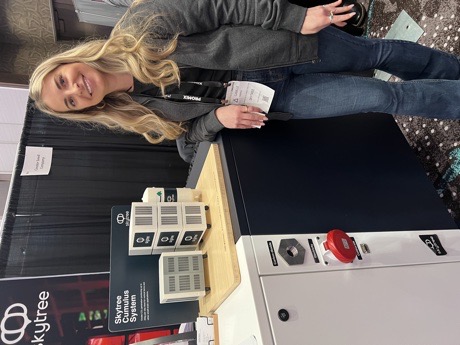
TECHNOLOGY
Skytree: Direct Carbon Capture
I wrote about Skytree when they first came on the U.S. scene last year, introducing the proof of concept version of their direct air carbon capture technology initially developed by the European Space Agency. They launched their Cumulus product in January, which is ideal for small-scale growing operations, producing up to 44 lbs. of CO2 daily. The systems are stackable, too, so one control unit can support up to three Cumulus units, and there’s an optional storage tank, as well.
At Indoor Ag-Con, they introduced the brand new Stratus series, which is made for larger indoor production facilities (both vertical farm and greenhouse). Here’s the breakdown:
- Stratus Hybrid 10: produces up to 1,100 lbs. of CO2 per day via the most energy-efficient system, using available thermal heat and electricity.
- Stratus Electric 10: produces up to 1,650 lbs. of CO2 per day, ideal for areas with access to cost-effective green electricity.
- Stratus Electric 20: produces 2,750 lbs. of CO2 per day as the highest capacity system designed to maximize CO2 capture capacity.
Talking to Camille Hanna, business development director, we asked about return on investment, which she said can depend on the comparative cost of CO2 in the grower’s location, but typically is between two and seven years. The company has tools to help interested growers calculate the total cost of ownership, and there are subsidy and incentive programs available to offset costs. Skytree also is looking at additional business models that would be available first on the Cumulus products.
Stratus units will be available likely later this year. Find out more at Skytree’s website.
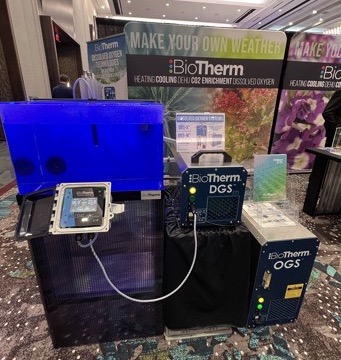
BioTherm: Dissolved Oxygen & CO2
BioTherm highlighted several products in their booth that focused on adding dissolved oxygen to irrigation water to improve root health and nutrient uptake in plants. The OGS Oxygen Generation System works by capturing oxygen out of the air and sending it through a dissolved gas system to increase the measurable dissolved oxygen in irrigation water. The unit is a plug-n-play and connects to BioTherm’s DOS-X Dissolved Oxygen System with flow rates up to 60gpm (with larger flow available through customization), or to the DGS-m Dissolved Gas System with flow rates up to 50gpm. Both the DOS-X and DGS systems can be controlled by the DO STAT Dissolved Oxygen Automation Controller with touchscreen interface.
CEO Jim Rearden told us an organic living lettuce grower using one of the dissolved oxygen systems trialed it and improved the weight of the lettuce from 5.5 ounces to 9 ounces with just the one change to production.
The company also showcased its CO2 enrichment machine that can make CO2 on-site, eliminating the need for tanks. The system pulls CO2 from the boiler’s exhaust gases and redistributes throughout the growing facility.
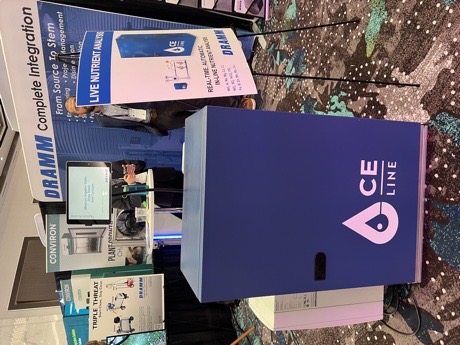
CE-Line (partnering with Dramm in the U.S.): Nutrient Analysis
How beneficial would it be to measure nutrient uptake in your crops in real-time? That’s what CE-Line offers, automated nutrient measurements for macro and micronutrients that is able to integrate into any growing system and result in a nutrient analysis within 45 minutes, said Simon Meijer, CEO of CE-Line.
The company has been trialing the technology in the Netherlands for years, and currently has installations in the Netherlands, Norway and Germany. They had been looking for additional partners, and found a U.S. partner in Dramm, in whose booth they were showing the technology. Simon noted that the tech reduces the risk of dosing mistakes, which can be caught early, and better addresses the needs of the crop to reduce plant stress. It can be vital to know what nutrients are in the water, too, if the operation is recycling water, and in cases where growers are optimizing lighting and nutrition they may need very specific dosing to achieve their goals.
The system is adaptable and can be integrated into any environmental control system, Simon said.
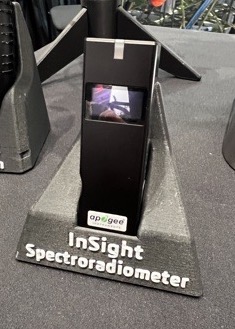
Apogee Instruments: Measurements
We saw two new products from Apogee Instruments: the new Insight Handheld Spectroradiometer MS-100 and the Guardian Multi-Sensor Monitor. First, the specroradiometer, a small, lightweight tool, allows growers to take spectral measurements and analyze grow lights. While it works particularly well for LEDs, you can also use it on other broad-spectrum light sources like high-pressure sodium or sunlight, said John Huber, technical sales support for Apogee Instruments. It was introduced late last year and has a wavelength sensitivity between 380 to 780 nm. It can take measurements anywhere and the unit can store them until downloaded onto a PC later.
This is a more accessible model than the lab models (those have higher resolution, but the MS-100 requires little setup), providing most growers the opportunity to get more specific lighting measurements. “Another feature that it has is its automatic calculations, allowing for measurements to show as spectrum data, color temperature data, wavelength ratios, and so on, making it a very versatile for a such a small handheld system,” John noted.
The Guardian Multi-Sensor Monitor has Bluetooth connectivity and measures a multitude of environmental factors, from fan-aspirated air temperature, humidity and VPD to DLI, instantaneous PAR/ePAR and more. It can work as a stand-alone device or it can be integrated into control systems for greenhouses, grow rooms and vertical farms using the Modbus protocol (both RS232 and RS485 are supported), John said.
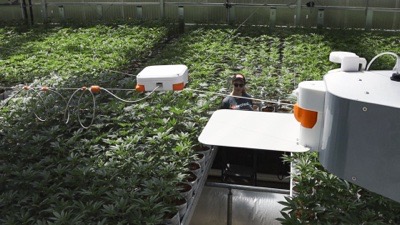 Neatleaf: Spyder Monitoring System
Neatleaf: Spyder Monitoring System
I met Elmar Mair, CEO and founder of Neatleaf, in the halls at Indoor Ag-Con and he told me about his company’s unique remote crop monitoring system. It’s a similar concept to the cable-suspended camera systems used by TV channels broadcasting NFL and college football games. So picture that, but with a flatter, square unit zooming over the crop, taking temperature, humidity, CO2 , leaf temperature, light intensity and other readings (you can see a demo of it in action on the website). It can remain one height above the plants, or it can zoom down closer into the plant canopy, Elmar said. It’s mounted to the greenhouse or vertical farm infrastructure, takes the readings and uploads the data to the cloud for access from anywhere. It uses proprietary AI technology to quantify plant health and forecast yield based on the collected data, as well.
The product was in development for four years and has been deployed in the field for two years now. Elmar added that growers can begin to compare year-over-year data, or from crop-to-crop to, for example, track how the crop is doing on Day 22 compared to the previous production cycle. The system is available in the U.S. and Canada currently, with the goal of expanding into Europe.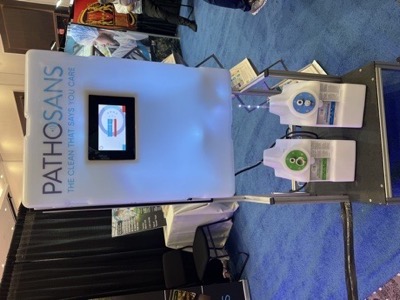
PathoSans: Sanitation
Food safety was one topic that received a fair amount of discussion at the show, and the wall-mounted, on-site compact concentrate generator from PathoSans was a great complement to that conversation. This unit, which is new this year and launched in January, generates two solutions: a sodium hydroxide cleaner/degreaser and hypochlorous acid disinfectant/sanitizer. It creates both out of salt, water and electricity, and the formulations are not irritating to the eyes and skin, which means employees don’t have to use respirators or full PPE when applying it.
The formulations can be used in foot baths, floor scrubbers, cleaning trays in propagation rooms and on equipment to kill all standard bacteria like E.coli, Salmonella and Listeria. There are multiple options depending on the amount of solution you need.
Hans Premium Water: Water Filtration
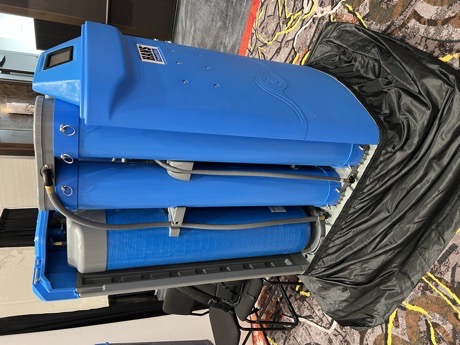 This is a company with a fascinating backstory: the founder is Manoj Bhargava, whose company launched 5-hour Energy Drink. He initially tasked the Hans Premium Water company with designing ways to clean dirty water in third-world countries in ways that could be easily managed and maintained. That technology has been brought to the commercial landscape in multiple industries, including CEA and agriculture, according to Jeff Nelson, national account executive for the company.
This is a company with a fascinating backstory: the founder is Manoj Bhargava, whose company launched 5-hour Energy Drink. He initially tasked the Hans Premium Water company with designing ways to clean dirty water in third-world countries in ways that could be easily managed and maintained. That technology has been brought to the commercial landscape in multiple industries, including CEA and agriculture, according to Jeff Nelson, national account executive for the company.
The result is a modular, reverse osmosis filtration option that offers up to 95% water recovery and low energy consumption on a small footprint. It’s scalable, too, allowing growers to add more output modules, pumps and treatment modules. Like the modules in other parts of the globe, it provides redundancies that allow for maintenance without taking the entire system offline, and easily accessible areas for quick maintenance.
SERVICES
DAG: Plan, Design & Build
Sometimes you don’t know what you don’t know, until it’s too late. The folks at DAG have made it their business to help CEA operations through the unknowns of planning, designing and constructing structures for indoor crop production, whether that’s greenhouse, indoor farm or something else.
I talked to CEO Mark Gemignani and COO Christopher Block during the show, and they talked about how can encompass the entire scope of a project, from planning to harvest, creating accountability at all levels of the process. They noted they are not tied to any set of vendors, but rather they vet multiple options for the specific project and provide their client with good, better, best options.
Oftentimes growers are sold a “turnkey system,” but it only accounts for part of the business, whether it’s the growing system or controls, but it doesn’t account for the operation as a whole. Then the grower is left to fill in the blanks on their own. Mark added, “The biggest challenge is growers don’t see it until they’ve done it on their own.”
They have worked with BrightFarms to construct three projects, as well as multiple in the cannabis space. Find out more at the DAG website.
SUBSTRATES
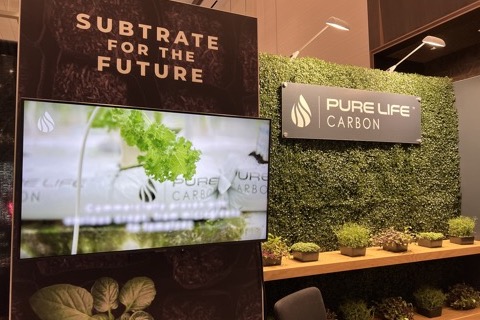 Pure Life Carbon: Growing Media
Pure Life Carbon: Growing Media
This is for the Canadians, particularly for those in the Leamington area (for now). There are essentially two bits of news here: Pure Life Carbon is producing a charged carbon standalone growing media (the first of its kind) that is essentially leased to the grower and able to be reused. That could be a bit of a game-changer for CEA growers looking to maximize their resources and offer a sustainable product.
Jim Hole, director of product science, walked us through how it works: growers use the growing media, which comes in slab bags, growing containers, bags and bulk; then the company retrieves it after the growing cycle; it’s reconditioned and returned to the inventory and the grower is delivered a new batch of media. The first processing facility is being built in Leamington, and the plan is to place processing facilities where there are regions of growers who would use the product. There are multiple types of product available depending on crops, which you can find at the Pure Life Carbon website.
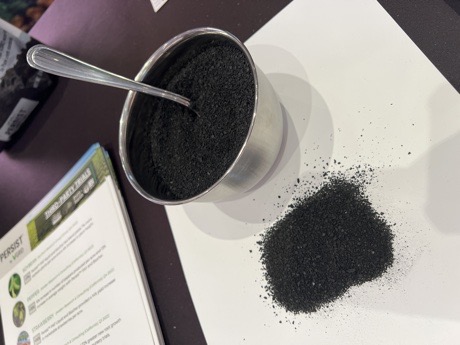 VGrid: Biochar
VGrid: Biochar
VGrid offered up a line of biochar products under the Persist label, including a micronized biochar for liquid fertigation, drip irrigation and foliar spray systems. It’s the first time I’d heard of a biochar option for use in liquid fertilization. The company offers it up in carefully screened particles less than 75 microns (.075mm), which can help improve water retention nutrient availability and microbial benefit.
Interestingly, the biochar is made from pistachio shells sourced from the Wonderful Company, according to Jeff Norton, vice president of business development, who told us about the product at the show. The pistachios go into water tank where they are shelled, then the shells are dried and VGrid takes them for processing. It’s an example of taking agricultural waste and using it effectively. But it’s not just about sustainability—VGrid has done third-party trials that show yield increases with the use of the Persist biochar products, including a 15% increase in yield and 40% water savings for a tomato grower in Hawaii.
PLANTS
Condor Seed Company: Microgreens
This may not be new, but they were new to me so I wanted to share—Arizona-based Condor Seed Company offers a wide variety of sprouts, microgreens and baby leaf greens. They work with 15 different growers to source the more than 300 varieties o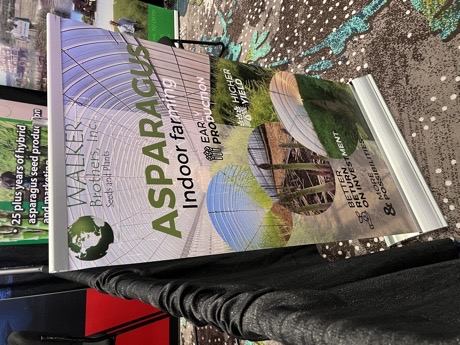 f seed they offer. A few new offerings (all three can be grown as a sprout, a microgreen or a baby leaf) include: a beautiful Tat Soi Scarlet Red, a spicy Wasabi mustard green and Mizuna Red Streak with a frilled leaf that is a dark red in the early stage.
f seed they offer. A few new offerings (all three can be grown as a sprout, a microgreen or a baby leaf) include: a beautiful Tat Soi Scarlet Red, a spicy Wasabi mustard green and Mizuna Red Streak with a frilled leaf that is a dark red in the early stage.
Walker Brothers: Asparagus Seed
Did you know you could grow asparagus in a controlled environment? We’re talking high tunnel production, and this method can cut down the long growing time from at least three years to harvesting the next year after sowing, according to Scott Walker at Walker Brothers Seeds & Plants. And they know asparagus, too—they are the largest producer of asparagus seed in the world! They were promoting the indoor option at the show, and it’s the first time I had heard of high tunnel asparagus cultivation. Scott noted research out of Japan that showed earlier harvest dates (which can be beneficial to hit that all-important Easter date) as well as quicker harvesting and increased yields over field-grown. Find out more at the Walker Brothers website.
BIOLOGICALS
Ceragen: Microbial Inoculant
Every aspect of plant nutrition and plant health is important to a high-yielding crop, and Ceragen aims to improve the plant’s ability to take in nutrients through its FerraGrow liquid microbial inoculant product. These are beneficial bacteria able to survive in a hydroponic environment that attach to the plant’s roots and allow for improved uptake and allowing the plant to better withstand stress. Matthew Rose, co-founder and CEO, told us they started testing the product with tomatoes in 2021 and have moved on to lettuce. Through commercial trial results growers were able to realize a 6.5% 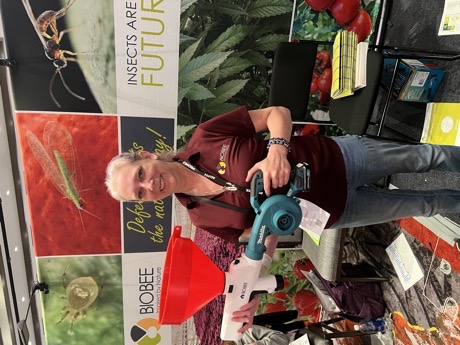 increase in yield for butterhead lettuce, 26-29% increase in Romaine and nearly 51% increase in Lollo, a curled leafy lettuce. They are working on developing formulations for strawberry and cucumber crops now, he added.
increase in yield for butterhead lettuce, 26-29% increase in Romaine and nearly 51% increase in Lollo, a curled leafy lettuce. They are working on developing formulations for strawberry and cucumber crops now, he added.
BioBee: BugFlow
Who wouldn’t want to use the BugFlow to release beneficial insects? For as fun as this product is, it’s also useful for growers looking for additional ways to disseminate beneficials consistently and uniformly throughout the crop. And a bonus to the grower, the “gun” is now shorter and lighter. I also talked with Sami Simmons, a technical sales representative at the BioBee booth, and she said they are working on an adapter to connect the cannister of beneficials right to the BugFlow. The benefits to this, along with consistency, is easy maneuverability in tight spaces, high survival rate of beneficials using this process and it can be used just about anywhere: open fields, greenhouses and indoor farms, among other locations. The company recommends using it with the Makita blower (shown here with Sami, but not sold with the BugFlow), but it can be used with DeWalt or Milwaukee with an adapter.
PACKAGING
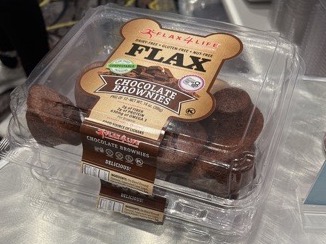 good natured: Biodegradable Packaging
good natured: Biodegradable Packaging
One of the best ways to get people to stop by your booth is to offer them brownies. Check and mate, good natured (by the way, the flax chocolate brownies were delicious). They did serve a higher purpose, though: they showed off the company’s plant-based packaging, which holds up throughout the packing line, shipping, the grocery store shelves and the home. The packaging is industrial compostable and made from agricultural food byproduct coming out of the Midwest U.S., typically corn, switchgrass or other starch-based products, said CEO Paul Antoniadis.
The company also offers options for leafy greens, microgreens and herb growers, as well as multi-use options. They have multiple locations in the U.S. and Canada, and Paul said they work with growers to understand their packing line and needs to have options tailored specifically for them. Currently they have about 1,000 customers in North America over several industries. Find out more at the good natured website.